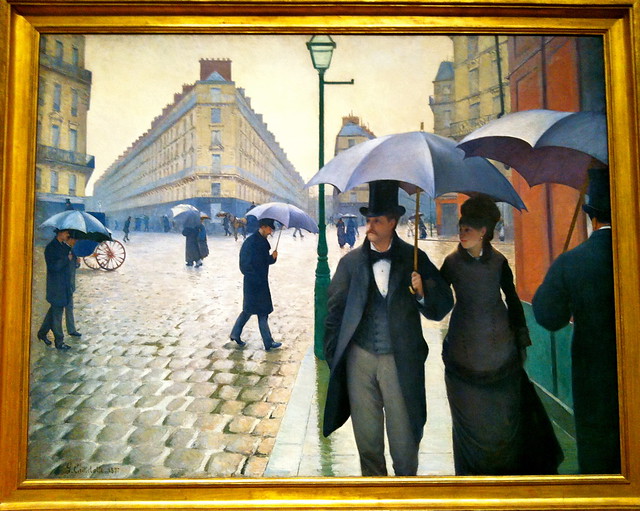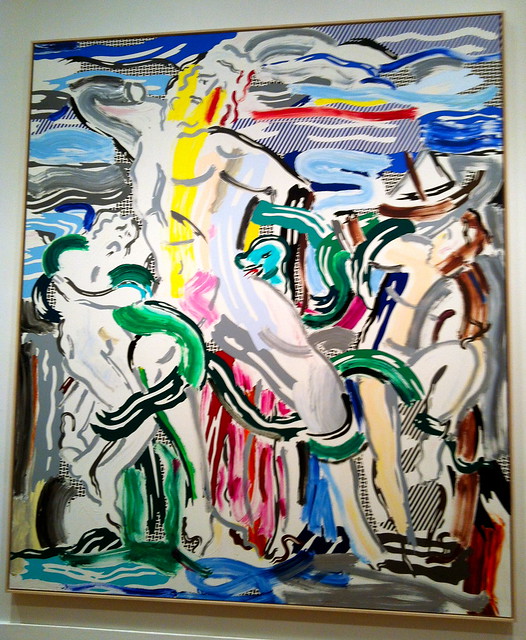May 16, 2013 | art history, Art Institute in Chicago, painting
A painter paints another painter in this picture, a man in blue holding a palette of colors. And since this is Picasso, it’s done in a style based off of his own. His figure is disjointed and geometricized, turned into shining cubes of color that hold pieces of a nose here and an ear there. It’s like looking at a realistic work by Picasso through an organized kaleidoscope.
Juan Gris was a Spanish painter and sculptor who met Picasso in France after moving to Paris in 1906. Gris regarded Picasso as a teacher, but Gertrude Stein wrote “Juan Gris was the only person whom Picasso wished away.”


These photographs were taken at the Art Institute in Chicago.
For more pictures of this museum’s work, see my Flickr album.
Apr 25, 2013 | art history, Art Institute in Chicago, painting
“The Eventuality of Destiny” shows what could be the Three Graces, or just three random goddesses who are trapped on all sides by gray walls and ceiling. The architecture creates a sense of confinement that’s relieved only under the arm of the featured goddess – a little patch of blue sky that holds three tiny clouds.
This featured goddess stands tall with her arm gracefully draped over her head, and her whole body seems to glow from within with bright fiery colors. The greens, blues and oranges nearly burst out of her assumed human form, and the only sitting goddess looks like she holds whole universes within her. The women overtake the manmade architecture behind them, three maidens in elegant postures and only one reveals her face, bright blue shadows cast across her cheek with the tops and bottoms of her eyes lined in bold streaks of white.

An Italian artist born in Greece, Giorgio de Chirico imagines the Greek goddesses as colossal creatures, perfect in form and covered in color. This painting gives a glorious hopeful portrayal of the supernatural beings in charge of our universe, and yet they’re still confined within the boundaries we created for them.
[zl_mate_code name=”twitter/facebook” label=”5″ count=”2″ link1=”http://www.twitter.com/share?url=https://thingsworthdescribing.com/2013/04/25/the-eventuality-of-destiny-by-giorgio-de-chirico-1927/” link2=”http://www.facebook.com/share.php?u=https://thingsworthdescribing.com/2013/04/25/the-eventuality-of-destiny-by-giorgio-de-chirico-1927/”] [/zl_mate_code]
[/zl_mate_code]
Photographs taken at the Art Institute in Chicago. For more photos from this museum, see my Flickr set.
And for more information about this painting or de Chirico, check out this JAMA article.
Sep 30, 2012 | Art Institute in Chicago, painting
Laocoön’s story comes from a lost play by Sophocles, that we know about through mentions by other Greek writers. He attempted to prove that the Trojan Horse was a trick by throwing his spear at it, but snakes were sent by Poseidon to stop him, and were thought by the Trojans to mean that the horse was sacred and not to be touched. Some versions of the story say that Athena blinded him first and then sent the snakes, but either way the gods were with the Greeks.
The sculpture of Laocoön and his sons Antiphantes and Thymbraeus being strangled by the serpent is attributed by the Roman writer Pliny the Edler to three sculptors from the island of Rhodes: Agesander, Athenodoros and Polydorus.
I remember the first time I saw this sculpture in my introductory art history class, and it was one of those right-where-you-wanna-be-in-life moments, after spending two years chasing majors that didn’t click.
This rendition by Roy Lichtenstein is one hell of a take – at this point in his life, he’s developed a recognizable style that can be applied to almost anything. He turned all of art history into bright, cartoonified refinement, using
Ben-Day dots for shading and colors galore. This Laocoon evokes the struggle and aesthetic of the masterpiece that inspired it, but makes it more of a lighthearted reference to one of the most influential works of art of all time – sort of nodding at it in thanks for all it’s contributed to the craft of aesthetics and beautiful things.
 |
| Cubist Still Life, 1974 |
 |
Frolic, 1977
Channelling surrealism:) |
You can see the rest of the Roy Lichtenstein retrospective on the Art Institute’s website here.
And the rest of my pictures from the Art Institute in Chicago here.
Sep 14, 2012 | Art Institute in Chicago, features, museums
Unfortunately I visited this museum on the last day of my trip to Chicago. Had I known how incredibly huge and impressive it is, I definitely would have dedicated double the time to soak all of it up.
Think of the most famous iconic artwork you can, and it’s probably sitting at the Art Institute. I felt like every corner I turned led me to another piece of art history – everything from “American Gothic” to tons of Picassos to van Gogh’s “The Room” – all of my favorites and a couple of new ones too.
 |
| Paris Street; Rainy Day by Gustave Caillebotte, 1877 |
 |
| American Gothic by Grant Wood, 1930 |

|
| New favorite! The Eventuality of Destiny by Giorgio de Chirico, 1927 |
It’s a funny thing finding a painting in a museum that you’ve studied and learned about through slides and textbooks. I imagine meeting up with someone from an online dating site would give you a similar feeling. Because you know so much about this piece and sometimes even the person who made it, which makes meeting it in person kind of phenomenal. Since its appearance never changes, I guess it’s more like meeting an old friend that always surpasses your expectations.
Whatever the feeling that I can’t do justice describing, it’s one I felt dozens of times at the Art Institute. Three straight floors of glass and slick pale wood was the perfect environment to see the works in; nothing extra where it wasn’t necessary. The rooms and hallways of beauty and masterpieces just kept coming and coming, so I’m just going to focus on my absolute favorites.
 |
| Nighthawks by Edward Hopper, 1942 |
The third floor European Modern Art gallery, from 1900-1950, was one of the greatest collections I’ve seen in so long. It could have been a substantial collection of work all on its own; maybe it’s own mini-museum. There were so many Picasso’s, Mattisse’s, and Dali’s – it always amazes me how much work those artists actually completed over the course of their lives, that they can be featured numerous times in hundreds of museums all around the world.
 |
| Detail of van Gogh’s The Room, 1888 |
American Modern Art was almost as great, well actually it was just as great, but in a different way. It’s really clear how different the styles of those two continents are after seeing these exhibits in succession. Right next to this space on the second floor was the featured exhibition, and when I visited I saw the Roy Lichtenstein retrospective.
I never really appreciated Roy Lichtenstein’s contributions until seeing this show, mostly because it was so hard for me to believe that they were actually oil paintings and not just pop art. But after seeing it as up close as the guards would let me, it was one part surprising and one part impressive to be wrong about how talented that man was. The show works chronologically, allowing us to really see how Lichtenstein developed his style and the different phases he went through during his progression as an artist. My favorite phase came later in his life, when he began to apply his own technique and style to the works of different artists and time periods. It really showed how great Lichtenstein had become – he had created such a unique visual language that could be applied to previous masterpieces, and it was so clear which aspects had come from where.
 |
| Masterpiece by Roy Lichtenstein, 1962 |
 |
| Laocoon by Roy Lichtenstein, 1988 |
Someday soon I’ll visit the Art Institute again. Comment if you’ve been – I want to hear what you thought of it!
You can see more of my pictures from the Art Institute in my Flickr set here.
Aug 15, 2012 | Art Institute in Chicago, MCA Chicago, museums
A million thanks to my boyfriend’s family who let me tag along on their family vacation to Chicago last week. They took me to the Shedd Aquarium, on an Architecture River Cruise, and stuck it out with me through (almost) both museums! Thanks to them I now have two great collections to add to my mini online database of photos, posts, and descriptions.
Four days in Chicago means we only had time for the highlights, so I chose to check out the Museum of Contemporary Art (MCA) Chicago and the Art Institute of Chicago.
| MCA Chicago |
The Art Institute of Chicago |
|
|
|
Open Tuesdays
10am-8pm
and Wednesdays-Sundays
10am-5pm (closed Mondays) |
Open Thursdays
10:30am-8pm
and Mondays-Sundays
10:30am-5pm |
Highlights:
- Skyscaper: Art and Architecture Against Gravity
- Heidi Norton’s Plants on the verge of a natural breakdown
|
Highlights:
- Roy Lichtenstein: A Retrospective
- European Modern Art, 1900-1950 – 3rd floor
- Impressionism Galleries – 2nd floor
- American Modern Art, 1900-1950 – 2nd floor
|
|
I’ll be publishing more in-depth posts on both museums in the next couple of days, so stay tuned if you want more info and descriptions on these beautiful places and all the wonderful art they contain. There’s nothing like walking into a brand new museum for the first time.




 [/zl_mate_code]
[/zl_mate_code]















